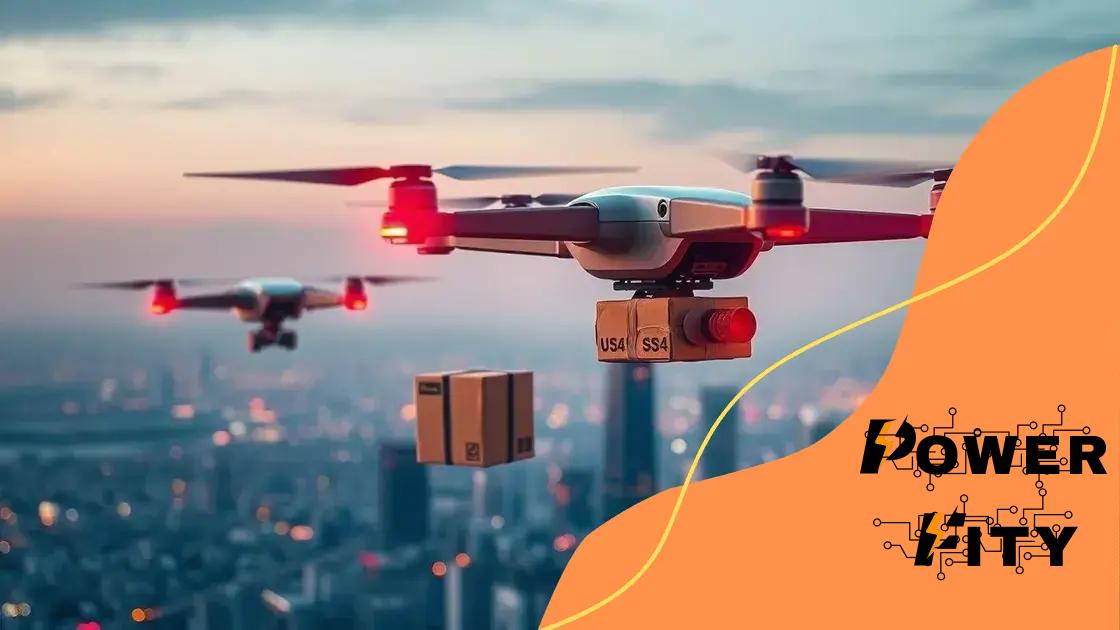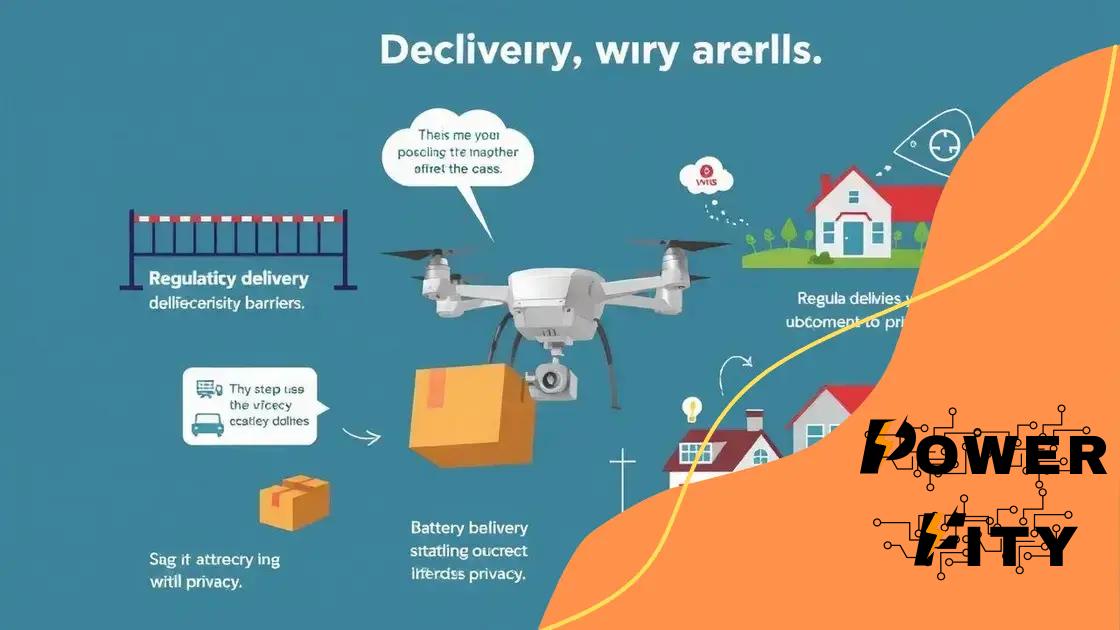Drones and autonomous systems in logistics: a revolution in delivery

Drones and autonomous systems in logistics enhance delivery speed, reduce costs, and improve efficiency, revolutionizing the supply chain with innovative applications across various industries.
Drones and autonomous systems in logistics are changing the way we think about delivery. Have you ever imagined getting your package within minutes instead of days? Let’s dive into how these technologies are making this a reality.
Understanding drones in logistics
Understanding drones in logistics is essential as they play a key role in improving delivery systems around the globe. These unmanned aerial vehicles are changing the way businesses operate, making logistics faster and more efficient. With the rise of technology, drones are becoming more accessible, leading to their increased use in various sectors.
How Drones Work in Logistics
Drones operate by utilizing advanced navigation and communication technologies. They are equipped with GPS and sensors that allow them to navigate safely through environments. This technology enables the autonomous systems to avoid obstacles and reach their destinations accurately and efficiently.
Benefits of Using Drones
- Speed: Drones can deliver packages quicker than traditional methods.
- Cost-Effectiveness: Reducing the need for ground transportation leads to lower delivery costs.
- Access to Hard-to-Reach Areas: Drones can easily reach remote or difficult locations.
- Environmentally Friendly: Drones use less fuel compared to delivery trucks.
As customers demand faster delivery times, drones are equipped to meet these needs. They can transport small packages directly from warehouses to customers within minutes. This capability is not just a trend; it represents the future of logistics.
In addition to speed, drones enhance efficiency. They allow businesses to reduce operational costs by minimizing labor and transportation expenses. This boost in efficiency translates to higher profit margins and better customer satisfaction.
However, the adaptation of drones in logistics does face challenges. Regulations regarding airspace, safety concerns, and technological limitations must be addressed as companies seek to implement these systems. As regulations evolve, so will the capabilities of these drones, ensuring they can safely operate alongside other air traffic.
In conclusion, understanding drones in logistics reveals how they are revolutionizing delivery systems. Their speed, cost-effectiveness, and ability to reach various locations highlight why they are an important aspect of modern logistics.
Benefits of autonomous systems for delivery
The benefits of autonomous systems for delivery are becoming increasingly apparent as technology advances. These systems leverage robotics and automation to streamline processes, improving efficiency and reducing costs. As businesses continue to adopt these technologies, they can expect significant transformations in how they deliver goods.
Enhanced Efficiency
One of the primary benefits of autonomous delivery systems is their ability to enhance efficiency. By automating repetitive tasks, companies can focus on more critical aspects of their operations. For instance, autonomous vehicles can navigate routes without human intervention, optimizing delivery times.
Cost Reduction
- Lower labor costs: Autonomous systems reduce the need for human drivers, which can cut payroll expenses significantly.
- Fuel efficiency: Many autonomous delivery systems are designed to optimize fuel use, resulting in cost savings.
- Maintenance savings: With fewer malfunctions and human errors, maintenance costs can also decrease.
Additionally, these systems can operate during off-peak hours, effectively reducing congestion and delivery times. This flexibility allows businesses to respond to customer needs rapidly.
Another compelling benefit is the ability of autonomous systems to enhance safety. By minimizing human errors, which are a leading cause of accidents in delivery, these technologies ensure safer roadways. Autonomous vehicles are equipped with advanced sensors and cameras to monitor their environment, significantly reducing the risk of collisions.
As we look forward, the scalability of autonomous systems represents a crucial advantage. Companies can easily expand their delivery capacities without proportionately increasing their workforce. This scalability allows for increased demand without additional costs, making it a sustainable choice for businesses wishing to grow.
Ultimately, the benefits of autonomous systems for delivery are vast, spanning from efficiency and safety to cost-effectiveness. These advantages position businesses at the forefront of the logistics and delivery sectors.
Challenges faced by drone delivery services

The challenges faced by drone delivery services are significant and must be addressed for this technology to thrive. As businesses explore the use of drones for logistics, they encounter various obstacles that impact implementation and public acceptance. Understanding these challenges is essential for effective solutions.
Regulatory Hurdles
One major challenge is navigating the complex regulations governing airspace. Governments around the world have strict guidelines for drone operation, focusing on safety and privacy. These regulations can vary greatly between regions, making it difficult for companies to establish consistent operations.
Technical Limitations
- Battery life: Many drones have limited flight times due to battery constraints, which can hinder long-distance deliveries.
- Payload capacity: Drones can only carry light packages, restricting the types of goods that can be delivered.
- Weather dependencies: Inclement weather can ground drones, affecting delivery schedules.
In addition, technological issues such as navigation and obstacle detection must be solved to ensure safe operation in urban environments. These technical limitations pose barriers to the widespread use and acceptance of drone delivery services.
Another significant challenge is public perception and acceptance. Concerns about privacy, noise, and safety often lead to resistance from communities. To gain broader acceptance, companies must engage with the public, addressing their fears and demonstrating the benefits of drone delivery.
Furthermore, competition can complicate the landscape. As more companies enter the market, finding a unique value proposition becomes essential. Standing out requires innovation and a solid business strategy that addresses the challenges previously mentioned.
By acknowledging these challenges faced by drone delivery services, companies can develop effective strategies to overcome them. Addressing regulatory, technical, and public relations hurdles will pave the way for successful integration of drones in logistics.
Real-world applications of logistics drones
Real-world applications of logistics drones are rapidly expanding as companies recognize their potential. These drones are already changing how goods are delivered, showcasing innovation in various industries. Discovering how drones are utilized in practical scenarios can provide insight into their transformative capabilities.
Emergency Deliveries
One significant application is in emergency delivery services. Drones can quickly transport medical supplies, such as blood or vaccines, to remote areas affected by natural disasters or health crises. This speed can be crucial in saving lives when every second matters.
Retail and E-commerce
- Package delivery: Many retail companies are testing drones for package deliveries, aiming to shorten delivery times.
- Last-mile solutions: Drones are ideal for achieving efficient last-mile deliveries, especially in dense urban areas.
- Time-sensitive products: Perishable goods can reach consumers swiftly, ensuring quality.
Moreover, large e-commerce companies are investing in drone technology to enhance their logistics networks. By reducing delivery times, they improve customer satisfaction and gain a competitive edge.
Another noteworthy application is in inventory management. Drones can be employed in warehouses to scan and manage stock levels with incredible speed and accuracy. Equipped with advanced sensors and cameras, they can identify products and update inventory counts in real time, streamlining operations and helping prevent stock shortages.
Agriculture is also benefiting from logistics drones. Farmers use drones for tasks such as monitoring crop health, assessing land conditions, and even delivering supplies directly to fields. This use enhances efficiency and allows for better resource management.
In summary, the real-world applications of logistics drones illustrate their potential to revolutionize various sectors. From emergency services to retail and agriculture, drones are paving the way for a smarter and faster logistics future.
The future of drones in logistics
The future of drones in logistics looks promising as technology continues to evolve. With advancements in artificial intelligence and machine learning, these unmanned aerial vehicles are set to revolutionize the way goods are delivered. Companies are already exploring innovative uses that will shape the logistics landscape.
Increased Efficiency and Speed
As drone technology progresses, we can expect even faster delivery times. Autonomous drones will become capable of flying more significant distances without needing to recharge frequently. This improvement will allow for quicker and more reliable deliveries, especially in urban areas where traffic congestion is common.
Enhanced Safety Features
- Obstacle avoidance: Future drones will be equipped with advanced sensors that help them navigate around obstacles, making missions safer.
- A.I. monitoring: Artificial intelligence will enable drones to monitor their surroundings and adjust routes in real-time to avoid hazards.
- Data analysis: Drones will gather data that helps improve their operations and safety standards.
These enhancements not only enhance safety but will also increase public acceptance of drone deliveries as safety concerns diminish.
Moreover, logistics companies may adopt hybrid models where drones work alongside traditional delivery methods. This approach can optimize delivery routes and reduce costs. Imagine a scenario where drones handle the last-mile delivery while trucks manage the bulk transportation. This combination could lead to more efficient supply chains.
As regulations evolve, we will likely see a gradual relaxation of airspace restrictions for commercial drone use. Governments may introduce new frameworks that facilitate drone operations, allowing them to operate in urban environments. This change will significantly expand the areas where drones can be deployed.
In addition, sustainability will drive the future of drones in logistics. Companies are increasingly seeking environmentally friendly solutions, and drones powered by renewable energy sources will play a crucial role in reducing carbon footprints. This shift towards greener delivery options will align with global efforts to combat climate change.
FAQ – Frequently Asked Questions about Drones in Logistics
What are the primary benefits of using drones in logistics?
Drones increase delivery speed, reduce costs, and can access hard-to-reach areas, enhancing overall efficiency.
How do drones ensure safety during deliveries?
Drones are equipped with advanced sensors to detect obstacles and avoid collisions, promoting safe operations.
What types of products can drones deliver?
Drones are suitable for delivering small packages, medical supplies, and perishable goods, among other items.
Will regulations affect the use of drones in logistics?
Yes, regulations play a crucial role. Companies must comply with local laws governing airspace and drone operations to ensure safe and legal deliveries.





